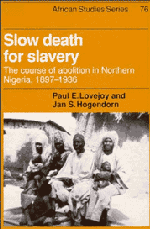Book contents
- Frontmatter
- Contents
- List of maps
- List of tables
- Preface
- 1 Slavery and the British conquest of Northern Nigeria
- 2 Fugitive slaves and the crisis in slavery policy
- 3 The debate on legal-status abolition
- 4 Emancipation and the law
- 5 Upholding proprietary rights to land
- 6 The role of taxation in the reform of slavery
- 7 The colonial economy and the slaves
- 8 The persistence of concubinage
- 9 Legal-status abolition: the final phase
- Appendix: Court records of slaves issued certificates of freedom
- Notes
- Glossary
- Bibliography
- Index
- Title in the series
4 - Emancipation and the law
Published online by Cambridge University Press: 03 May 2011
- Frontmatter
- Contents
- List of maps
- List of tables
- Preface
- 1 Slavery and the British conquest of Northern Nigeria
- 2 Fugitive slaves and the crisis in slavery policy
- 3 The debate on legal-status abolition
- 4 Emancipation and the law
- 5 Upholding proprietary rights to land
- 6 The role of taxation in the reform of slavery
- 7 The colonial economy and the slaves
- 8 The persistence of concubinage
- 9 Legal-status abolition: the final phase
- Appendix: Court records of slaves issued certificates of freedom
- Notes
- Glossary
- Bibliography
- Index
- Title in the series
Summary
Lugard's strategy to reform slavery was off to a hesitant start. While the High Commissioner had prevailed over both the “Movement” and the Colonial Office in the policy debate, slaves had fled in large numbers, with desertions probably numbering in the hundreds of thousands by 1906. Despite the crisis surrounding the slavery issue, however, Lugard maintained a clear vision of the reforms he intended to implement. He still desired that slavery be phased out gradually. By 1903 the supply of new slaves had been reduced to a trickle because slave raiding and the trade in slaves were prohibited and because children born after March 31, 1901 were free. While there was still some kidnapping, and slave raiding continued across the border in German territory, there was no question that the number of slaves entering the market was dwindling rapidly.
The main unfinished issue in Lugard's plan to undermine slavery involved how slaves might obtain their freedom other than through desertion. For that purpose, Lugard looked to Islamic practices that allowed slaves to acquire their freedom through self-purchase or redemption by third parties. British reforms attempted to make these practices obligatory upon demand. This tended to favor male slaves, and hence much of the following discussion is concerned with the fate of male slaves. Female slaves were consigned to a different category that had to do with the male chauvinism of Islamic society and Edwardian England.
- Type
- Chapter
- Information
- Slow Death for SlaveryThe Course of Abolition in Northern Nigeria 1897–1936, pp. 98 - 126Publisher: Cambridge University PressPrint publication year: 1993

